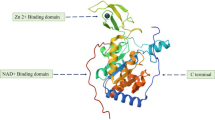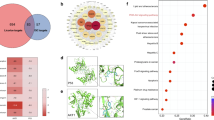Abstract
Aim
Oxidative stress and the inflammatory response contribute to the progression of cardiovascular disease. The present study aimed to investigate whether the mitochondrial-derived peptide MOTS-c could alleviate H2O2-induced oxidative stress and inflammatory status in H9c2 cells through activation of nuclear factor erythroid 2-related Factor 2 (Nrf2)/antioxidative response element (ARE) and inhibition of the NF-κB pathway.
Methods
Rat H9c2 cardiomyocytes were obtained, and 10, 20 or 50 μM MOTS-c was pretreated for 24 h before treatment with H2O2. Then, the cell was treated with 100 μM H2O2 for 1 h to induce oxidative stress. An inhibition model of sh-Nrf2 was constructed via a lentivirus expression system, and an activation model of NF-κB was achieved using phorbol 12-myristate-13-acetate (PMA). Cell viability was determined using a Cell Counting kit-8 assay. Relative measurement of relative protein and mRNA expression used western blotting and qRT-PCR, respectively. Intracellular reactive oxygen species (ROS) levels were detected using dichlorodihydrofluorescein diacetate, and malondialdehyde (MDA) and superoxide dismutase (SOD) levels were determined via commercial kits. The protein expression and distribution in the cells were visualized by immunofluorescence analysis. Enzyme-linked immunosorbent assay was used to detect the levels of inflammatory cytokines, including TNF-α, IL-6 and IL-1β.
Results
We found that H2O2 treatment significantly decreased cell viability and the level of SOD, increased the levels of ROS and MDA, and upregulated the expression of inflammatory cytokines, including TNF-α, IL-6 and IL-1β, in H9c2 cells. The expression levels of Nrf2, HO-1 and NQO-1 were significantly downregulated in the H2O2, while the phosphorylation of NF-κBp65 was promoted by H2O2. However, pretreatment with MOTS-c significantly reversed H2O2-induced damage in H9c2 cells. Moreover, both inhibition of the Nrf2/ARE pathway and activation of the NF-κB pathway significantly decreased the effects of MOTS-c, suggesting that MOTS-c might play a role in alleviating oxidative damage via the Nrf2/ARE and NF-κB pathways.
Conclusions
Our investigation indicated that MOTS-c could protect against H2O2-induced inflammation and oxidative stress in H9c2 cells by inhibiting NF-κB and activating the Nrf2/ARE pathways.





Similar content being viewed by others
References
Bundy, J. D., and J. He. Hypertension and related cardiovascular disease burden in China. Ann. Glob. Health. 82(2):227–233, 2016.
Chang, H., C. Li, K. Huo, Q. Wang, L. Lu, Q. Zhang, et al. Luteolin prevents H2O2-induced apoptosis in H9C2 cells through modulating Akt-P53/Mdm2 signaling pathway. Biomed. Res. Int. 2016:5125836, 2016.
Chen, Q. M., and A. J. Maltagliati. Nrf2 at the heart of oxidative stress and cardiac protection. Physiol. Genomics. 50(2):77–97, 2018.
Del Olmo-Garcia, M. I., and J. F. Merino-Torres. GLP-1 receptor agonists and cardiovascular disease in patients with type 2 diabetes. J. Diabetes Res. 2018:4020492, 2018.
Dias, A. T., A. S. Cintra, J. C. Frossard, Z. Palomino, D. E. Casarini, I. B. Gomes, et al. Inhibition of phosphodiesterase 5 restores endothelial function in renovascular hypertension. J. Transl. Med. 12:250, 2014.
Ebrahimi, B., J. A. Crane, B. E. Knudsen, S. I. Macura, J. P. Grande, and L. O. Lerman. Evolution of cardiac and renal impairment detected by high-field cardiovascular magnetic resonance in mice with renal artery stenosis. J. Cardiovasc. Magn. Reson. 15(1):98, 2013.
Fang, M., W. H. Zhong, W. L. Song, Y. Y. Deng, D. M. Yang, B. Xiong, et al. Ulinastatin ameliorates pulmonary capillary endothelial permeability induced by sepsis through protection of tight junctions via inhibition of TNF-α and Related pathways. Front. Pharmacol. 9:823, 2018.
Gaspari, T., H. Liu, I. Welungoda, Y. Hu, R. E. Widdop, L. B. Knudsen, et al. A GLP-1 receptor agonist liraglutide inhibits endothelial cell dysfunction and vascular adhesion molecule expression in an ApoE-/- mouse model. Diab. Vasc. Dis. Res. 8(2):117–124, 2011.
Ghorpade, D. S., L. Ozcan, Z. Zheng, S. M. Nicoloro, Y. Shen, E. Chen, et al. Hepatocyte-secreted DPP4 in obesity promotes adipose inflammation and insulin resistance. Nature. 555(7698):673–677, 2018.
Hu, B. T., and W. Z. Chen. MOTS-c improves osteoporosis by promoting osteogenic differentiation of bone marrow mesenchymal stem cells via TGF-β/Smad pathway. Eur. Rev. Med. Pharmacol. Sci. 22(21):7156–7163, 2018.
Li, D., X. Wang, Q. Huang, S. Li, Y. Zhou, and Z. Li. Cardioprotection of CAPE-oNO(2) against myocardial ischemia/reperfusion induced ROS generation via regulating the SIRT1/eNOS/NF-κB pathway in vivo and in vitro. Redox Biol. 15:62–73, 2018.
Liu, C., E. K. Gidlund, A. Witasp, A. R. Qureshi, M. Söderberg, A. Thorell, et al. Reduced skeletal muscle expression of mitochondrial-derived peptides humanin and MOTS-C and Nrf2 in chronic kidney disease. Am. J. Physiol. Renal. Physiol. 317(5):F1122–F1131, 2019.
Muzumdar, R. H., D. M. Huffman, G. Atzmon, C. Buettner, L. J. Cobb, S. Fishman, et al. Humanin: a novel central regulator of peripheral insulin action. PLoS ONE. 4(7):e6334, 2009.
North, B. J., and D. A. Sinclair. The intersection between aging and cardiovascular disease. Circ. Res. 110(8):1097–1108, 2012.
Priestley, J. R. C., K. E. Fink, J. M. McCord, and J. H. Lombard. NRF2 activation with Protandim attenuates salt-induced vascular dysfunction and microvascular rarefaction. Microcirculation. 26(7):e12575, 2019.
Qin, Q., S. Delrio, J. Wan, R. Jay Widmer, P. Cohen, L. O. Lerman, et al. Downregulation of circulating MOTS-c levels in patients with coronary endothelial dysfunction. Int. J. Cardiol. 254:23–27, 2018.
Qiu, Z., Y. He, H. Ming, S. Lei, Y. Leng, and Z. Y. Xia. Lipopolysaccharide (LPS) aggravates high glucose- and hypoxia/reoxygenation-induced injury through activating ROS-dependent NLRP3 inflammasome-mediated pyroptosis in H9C2 cardiomyocytes. J. Diabetes Res. 2019:8151836, 2019.
Ran, N., C. Lin, L. Leng, G. Han, M. Geng, Y. Wu, et al. MOTS-c promotes phosphorodiamidate morpholino oligomer uptake and efficacy in dystrophic mice. EMBO Mol. Med. 13(2):e12993, 2021.
Sajadimajd, S., and M. Khazaei. Oxidative stress and cancer: the role of Nrf2. Curr. Cancer Drug Targets. 18(6):538–557, 2018.
Simonson, B., and S. Das. MicroRNA therapeutics: the next magic bullet? Mini Rev. Med. Chem. 15(6):467–474, 2015.
Sternik, L., S. Samee, H. V. Schaff, K. J. Zehr, L. O. Lerman, D. R. Holmes, et al. C-reactive protein relaxes human vessels in vitro. Arterioscler. Thromb. Vasc. Biol. 22(11):1865–1868, 2002.
Steven, S., K. Frenis, M. Oelze, S. Kalinovic, M. Kuntic, M. T. Bayo Jimenez, et al. Vascular inflammation and oxidative stress: major triggers for cardiovascular disease. Oxid. Med. Cell Longev. 2019:7092151, 2019.
Sun, H. J., Z. Y. Wu, X. W. Nie, and J. S. Bian. Role of endothelial dysfunction in cardiovascular diseases: the link between inflammation and hydrogen sulfide. Front. Pharmacol. 10:1568, 2019.
Tahara, A., E. Kurosaki, M. Yokono, D. Yamajuku, R. Kihara, Y. Hayashizaki, et al. Effects of SGLT2 selective inhibitor ipragliflozin on hyperglycemia, hyperlipidemia, hepatic steatosis, oxidative stress, inflammation, and obesity in type 2 diabetic mice. Eur. J. Pharmacol. 715(1–3):246–255, 2013.
Wei, M., L. Gan, Z. Liu, L. Liu, J. R. Chang, D. C. Yin, et al. Mitochondrial-derived peptide MOTS-c attenuates vascular calcification and secondary myocardial remodeling via adenosine monophosphate-activated protein kinase signaling pathway. Cardiorenal. Med. 10(1):42–50, 2020.
Wojciechowska, A., A. Braniewska, and K. Kozar-Kamińska. MicroRNA in cardiovascular biology and disease. Adv. Clin. Exp. Med. 26(5):865–874, 2017.
Xu, W., J. Chen, J. Lin, D. Liu, L. Mo, W. Pan, et al. Exogenous H2S protects H9c2 cardiac cells against high glucose-induced injury and inflammation by inhibiting the activation of the NF-κB and IL-1β pathways. Int. J. Mol. Med. 35(1):177–186, 2015.
Yan, Z., S. Zhu, H. Wang, L. Wang, T. Du, Z. Ye, et al. MOTS-c inhibits osteolysis in the Mouse Calvaria by affecting osteocyte-osteoclast crosstalk and inhibiting inflammation. Pharmacol. Res. 147:104381, 2019.
Yen, K., C. Lee, H. Mehta, and P. Cohen. The emerging role of the mitochondrial-derived peptide humanin in stress resistance. J. Mol. Endocrinol. 50(1):R11–R19, 2013.
Zhang, G., X. Zou, Y. Huang, F. Wang, S. Miao, G. Liu, et al. Mesenchymal stromal cell-derived extracellular vesicles protect against acute kidney injury through anti-oxidation by enhancing Nrf2/ARE activation in rats. Kidney Blood Press. Res. 41(2):119–128, 2016.
Zhu, H., Y. Li, M. X. Wang, J. H. Wang, W. X. Du, and F. Zhou. Analysis of cardiovascular disease-related NF-κB-regulated genes and microRNAs in TNFα-treated primary mouse vascular endothelial cells. J. Zhejiang Univ. Sci. B. 20(10):803–815, 2019.
Funding
This work was supported by Funding of the Plan of Science and Technology on Medical and Health in Zhejiang Province (Nos. 2021KY1002, 2022KY312), Ningbo province public welfare project (No. 20211JCGY020364) and Natural Science Foundation of Ningbo (No. 2021J266).
Conflict of interest
The authors ensure that they have no conflict of interests.
Author information
Authors and Affiliations
Corresponding authors
Additional information
Associate Editor Igor Efimov oversaw the review of this article.
Publisher's Note
Springer Nature remains neutral with regard to jurisdictional claims in published maps and institutional affiliations.
Rights and permissions
About this article
Cite this article
Shen, C., Wang, J., Feng, M. et al. The Mitochondrial-Derived Peptide MOTS-c Attenuates Oxidative Stress Injury and the Inflammatory Response of H9c2 Cells Through the Nrf2/ARE and NF-κB Pathways. Cardiovasc Eng Tech 13, 651–661 (2022). https://doi.org/10.1007/s13239-021-00589-w
Received:
Accepted:
Published:
Issue Date:
DOI: https://doi.org/10.1007/s13239-021-00589-w




